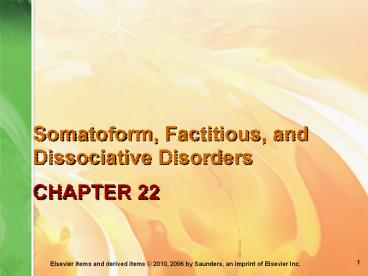Somatoform, Factitious, and Dissociative Disorders - PowerPoint PPT Presentation
Title:
Somatoform, Factitious, and Dissociative Disorders
Description:
Title: Chapter 022 Subject: Somatoform, Factitious, and Dissociative Disorders Author: Varcarolis Description: Foundations of Psychiatric Mental Health Nursing, 6/e – PowerPoint PPT presentation
Number of Views:559
Avg rating:3.0/5.0
Title: Somatoform, Factitious, and Dissociative Disorders
1
CHAPTER 22
- Somatoform, Factitious, and Dissociative
Disorders
2
Somatoform Disorders
- Physical symptoms suggest a physical disorder for
which there is no demonstrable base - Strong presumption that symptoms linked to
psychobiological factors
3
Somatoform Disorders
- Somatization disorder
- Undifferentiated somatoform disorder
- Conversion disorder
- Pain disorder
- Hypochondriasis
- Body dysmorphic disorder
- Somatoform disorder not otherwise specified
4
Somatization Disorder
- Most common somatoform disorder
- Significant functional impairment
- Symptoms
- Pain, GI symptoms, sexual symptoms, and
pseudoneurological symptoms - Course of illness chronic and relapsing
- Suicide threats and gestures common
5
Hypochondriasis
- Misinterpretation of physical sensations
- Overconcern for health and preoccupied with
symptoms - Extreme worry and fear
- Course of illness chronic and relapsing
6
Pain Disorder
- Diagnostic testing rules out organic cause
- Discomfort leads to impairment
- Associated with higher rates of depression
- Usual sites of pain are head, face, lower back,
pelvis
7
Body Dysmorphic Disorder
- Preoccupation with an imagined defective body
part - Obsessional thinking and compulsive behavior
- Fear of rejection by others, perfectionism, and
conviction of being disfigured lead to emotions
of disgust, shame and depression
8
Conversion Disorder
- Presence of deficits in voluntary motor or
sensory functions - Common symptoms paralysis, blindness, movement
and gait disorders, numbness, paresthesias, loss
of vision or hearing, or episodes resembling
epilepsy - La belle indifférence versus distress
- Comorbid conditions depression, anxiety, other
somatoform disorders, personality disorders
9
Etiology
- Biological factors
- Genetics
- Biochemical imbalances that cause pain to be
experienced more intensely - Psychosocial factors
- Psychoanalytic theory
- Behavioral theory
- Cognitive theory
10
Somatoform Disorders Assessment
- Symptoms and unmet needs
- Voluntary control of symptoms
- Secondary gains
- Cognitive style
- Ability to communicate feelings and emotional
needs - Dependence on medication
11
Somatoform DisordersImplementation
- Basic level interventions
- Promotion of self-care activities
- Health teaching and health promotion
- Case management
- Pharmacological interventions
- Advanced practice interventions
- Psychotherapy
12
Factitious Disorders
- Consciously pretend to be ill to get emotional
needs met and attain status of patient - Three subtypes
- Predominately physical symptoms
- Predominantly psychological symptoms
- Combinations of physical and psychological
symptoms
13
Examples of Factitious Disorders
- Factitious disorder with physical symptoms
- Munchausen syndrome
- Factitious disorder with psychological symptoms
- Factitious disorder by proxy
14
Malingering
- Symptoms are consciously produced or feigned
- Have various motivations, including financial
gain, relief of work duties, or obtaining illicit
drugs - Obvious secondary gain(s)
15
Dissociative Disorders
- Disturbances in the normally well-integrated
continuum of consciousness, memory, identity, and
perception - Unconscious defense mechanism
- Protects individual against overwhelming anxiety
16
Depersonalization Disorder
- Alteration in perception of self
- Reality testing remains intact
- Disturbing experiences of
- Feeling a sense of deadness of the body
- Seeing oneself from a distance
- Perceiving limbs to be larger or smaller than
normal
17
Dissociative Amnesia
- Inability to recall important personal
information - Often of traumatic or stressful nature
- Generalized amnesia
- Localized amnesia
- Selective amnesia
18
Dissociative Fugue
- Sudden unexpected travel away from the customary
locale - Inability to recall ones identity and some or
all of the past - During fugue state tend to live simple, quiet
lives - When former identity remembered, become amnestic
for time spent in fugue state
19
Dissociative Identity Disorder
- Presence of two or more distinct personality
states - Primary personality (host) usually not aware of
alters - Alternate personality (alters) or
subpersonalities take control of behavior - Alters often aware of each other
- Each alter thinks and behaves as a separate
individual
20
Dissociative Disorders Assessment
- Identity and memory
- History
- Moods
- Impact on patient and family
- Suicide risk
21
Dissociative DisordersImplementation
- Basic level interventions
- Milieu therapy
- Health teaching and health promotion
- Pharmacological interventions
- Advanced practice interventions
- Cognitive-behavioral therapy
- Psychodynamic psychotherapy
22
Personal Challenges to Professional Practice
- Focus on your feelings and be cognizant of your
reactions. - Monitor your own feelings of defensiveness,
impatience, frustration, or anger toward the
client. - Practice increased self-awareness.
- Dont judge, criticize, or make assumptions.
- Pain is determined and defined by the client.
- Pain of psychic origin is as hurtful as pain of
biologic origin.
23
Personal Challenges to Professional Practice
- Be alert for signs of secondary gain.
- Avoid reinforcing negative behaviors.
- Address client with a matter-of-fact approach.
- Reinforce adaptive vs. maladaptive behaviors.































